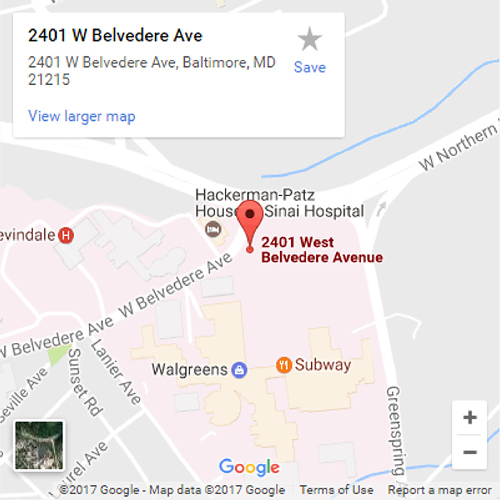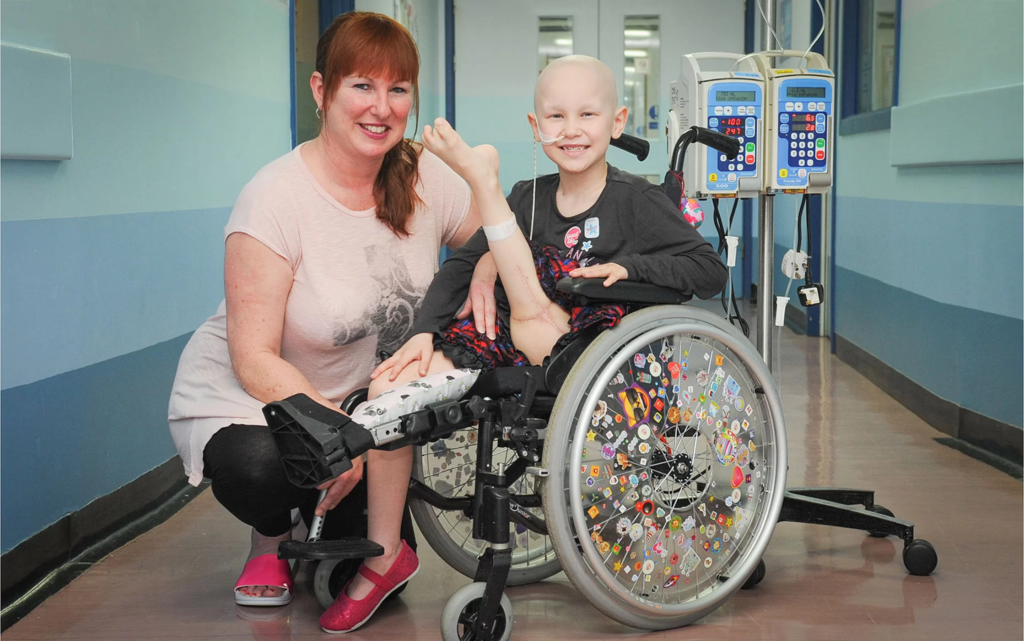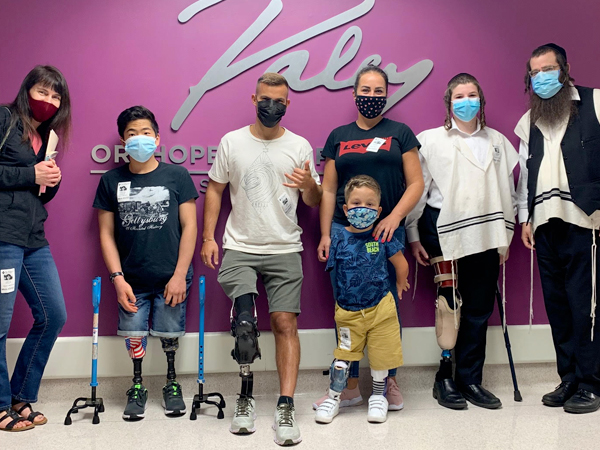What is a rotationplasty
What is a rotationplasty
Rotationplasty
Overview
What is rotationplasty?
Rotationplasty is a surgery to amputate (remove) the middle part of your leg when there is a tumor near your knee. Your surgeon rotates the lower section of your leg (shin bone, ankle and foot) 180 degrees. So, your foot points backwards. They reattach it to your remaining thigh bone. The ankle serves as a replacement knee joint. You wear a prosthesis (artificial limb) on your foot. Generally speaking, a rotationplasty leaves you with greater function than you would have with a standard amputation.
Van Nes rotationplasty is another name for this procedure.
Who needs to have rotationplasty?
People with knee tumors from osteosarcoma or Ewing sarcoma (types of bone cancer) may need rotationplasty. The procedure is more common in children and teenagers since osteosarcoma mostly affects this age group.
Children and teenagers are also better candidates for rotationplasty because their bones are still growing. Their reattached leg continues to grow as they grow, so they can adapt to more activities.
In some cases, children and adults with the following conditions may need rotationplasty:
Who shouldn’t have rotationplasty?
People with the following conditions shouldn’t have rotationplasty:
How common is rotationplasty?
Rotationplasty isn’t a common procedure. Not many healthcare providers have experience performing rotationplasty. In addition, parents and children may be hesitant to choose rotationplasty because of the uncommon appearance of the foot and ankle.
Procedure Details
How do I prepare for rotationplasty?
A rotationplasty requires careful preparation and planning:
What happens during rotationplasty?
Rotationplasty includes the following steps:
What happens after rotationplasty?
After your surgery, you stay in an intensive care unit (ICU) for at least a few days. You might stay in the hospital for up to a week. A team of healthcare providers monitors your leg, foot and toes carefully.
It may take three to six months for the bones in your leg to heal. If you receive chemotherapy for bone cancer after surgery, healing may take longer. You wear a cast on your leg and may need a wheelchair or crutches to move around.
Physical therapy is an important part of recovering from rotationplasty. A physical therapist helps you regain strength and flexibility in your hip and ankle joints. A therapist also shows you how to use your new “knee joint” to perform activities.
Once your leg heals, you start using a prosthesis. It’s important to have a prosthesis that’s specially made for someone recovering from rotationplasty. A poorly fitted prosthesis can lead to complications and mobility problems. As you grow, you will need new prostheses.
Functional results with a well-fitted prosthesis often exceed patient expectations. After three to six months, you’ll be able to walk without aid. Most people can return to sports activities, work or attend school within six to 12 months after the procedure.
Risks / Benefits
What are the risks of rotationplasty?
The biggest risks immediately after surgery include:
Complications that can occur during the healing process or long after surgery may include:
What are the benefits of rotationplasty?
Rotationplasty offers several advantages over other procedures, including:
Recovery and Outlook
What is the outlook after rotationplasty?
Most children do well after rotationplasty. Since their bones are still growing, it’s easier for them to adapt to the prosthesis. They’re usually able to return to many activities such as running or playing soccer. Adults may have a longer adjustment period with the prosthesis.
As children grow, they’ll need new prostheses. How often will depend on their rate of growth. They might need to work with a physical therapist each time they get a new prosthesis.
Will I need a second surgery?
Most people who have rotationplasty don’t need a second surgery unless there are complications. In rare cases, issues like fractures or blood vessel problems may need a full-leg amputation.
A note from Cleveland Clinic
Rotationplasty is a surgery for bone cancer near the knee. A surgeon removes the middle part of your leg, including the knee. They reattach the lower shin, ankle and foot to the remaining thigh bone. They also rotate the lower leg 180 degrees so the ankle joint functions as a knee joint. A prosthesis, or artificial limb, attaches to your foot. People who have rotationplasty usually have much better mobility than people who have a full leg amputation.
Last reviewed by a Cleveland Clinic medical professional on 05/10/2021.
References
Cleveland Clinic is a non-profit academic medical center. Advertising on our site helps support our mission. We do not endorse non-Cleveland Clinic products or services. Policy
Rotationplasty
What is rotationplasty?
Rotationplasty, also called Van Nes rotationplasty, is a rarely done surgical procedure where the patient’s lower leg is rotated backwards and the joints are relocated to serve new roles. The ankle and foot function as a knee joint within a prosthesis. The knee functions as the hip joint.
When is rotationplasty recommended?
Rotationplasty can be used as an alternative to leg amputation. At the International Center for Limb Lengthening, we sometimes uses rotationplasty for the most severe forms of congenital femoral deficiency (CFD), also called proximal femoral focal deficiency (PFFD), if there is no true hip joint and a significant limb length discrepancy. Rotationplasty may also be performed when a child has a large section of bone removed from the thigh bone (femur) during cancer treatment.
What happens to the leg during the rotationplasty procedure?
If the hip is severely deformed or unstable, and the femur is very deficient, then a Van Nes rotationplasty can be done to create a functional limb. The upper femur is removed, and the knee is then raised up to the level of the hip. The ankle is now at the level of the opposite normal knee. The leg is then rotated 180° so that the foot is facing backwards. The knee is stabilized to the pelvis and serves as the new hip joint. The ankle now serves as the new knee. After the procedure, a spica cast is applied for six weeks.
At what age is the rotationplasty performed?
For cases of severe congenital short femurs, surgery is generally performed between the ages of two and four, with ages three to four being most common. Children under the age of four will not have memory of this procedure. In less common situations, rotationplasty may be performed for older children, and even in adults.
How long does the rotationplasty procedure take?
The surgery typically takes between six to eight hours. Blood transfusions may need to be done.
How long must patients stay in the hospital after the rotationplasty?
Usually the patient will be admitted to the intensive care unit for one or two days. Time spent in the hospital afterward varies, but is usually five to six days.
How much of the body does the spica cast cover?
The spica cast will extend from the patient’s lower chest or stomach to their ankles.
How long must the spica cast be worn?
The spica cast must be worn for approximately six weeks. Two weeks after surgery, once the swelling has gone down, the cast is changed in a second surgery; this allows the surgeon to examine the surgical site. That second cast is left in place until 6 weeks after the original surgery. A third short surgery occurs at approximately that six week mark. During this surgery, the pins that were inserted into the foot and ankle are removed and the cast is converted into a removable brace. This allows the prosthetist to be able to measure for a prosthesis, while still providing some protection.
How long does physical therapy last?
Physical therapy is vital to the success of the procedure. This will help the patient learn to use the new prosthesis, as well as strengthen the ankle and improve the range of motion of the leg. Physical therapy does not begin until after the cast is removed at six weeks. At that time, therapy begins for range of motion and desensitization of the skin. Once the prosthesis is available, the child may begin weight bearing. Physical therapy usually starts at 3-4 times per week for 6-12 months, and is gradually weaned down to a home therapy program. Most toddlers are enrolled into infants and toddlers programs near their homes and are provided on-going therapy through that local program.
What is the timeline between surgery and returning home?
The majority of families stay in Baltimore for the two-week period until the first cast change. After the cast change, the family can usually return home if that is a convenient option, and then return in four weeks for the next step. After the last cast is removed, most families still stay in Baltimore for about two weeks in order to have the prosthetist measure and build the prosthesis, since it may be difficult to find a prosthetist near their homes that is used to making this type of prosthesis.
How mobile will the patient be after leaving the hospital?
While in the spica cast, the child can be transported in a wheelchair or stroller. Walking usually begins within 2-4 weeks once the prosthesis is completed and fitted to the patient.
What are the benefits of rotationplasty?
Rotationplasty allows the patient to keep much more of the affected leg than amputation. While the backwards position of the leg may seem shocking, it allows for the patient to have much greater mobility than he/she would have with a fully prosthetic leg. Patients are able to walk, run, jump and participate in sports and other activities.
Why choose the International Center for Limb Lengthening for rotationplasty surgery?
Van Nes rotationplasty surgery is only performed in a few centers around the world. At the International Center for Limb Lengthening, we have a lot of experience doing this operation; we perform the procedure about four times per year. Our patients benefit from our team-centered approach with world-renowned surgeons and specialized physician assistants, nurses and physical therapists. We help patients having Van Nes rotationplasty surgery achieve their best possible result.
The International Center for Limb Lengthening at the Rubin Institute for Advanced Orthopedics at Sinai Hospital was specifically designed for the complex treatment of limb deformities. The building has physician offices, six operating rooms specially designed for limb lengthening and deformity correction procedures, and physical therapy gyms all right on site at Sinai Hospital. An apartment-style housing facility, the Hackerman-Patz House, was built across the street from the hospital to accommodate families during treatment. The Baltimore Ronald McDonald House is also available for families to stay at while a child undergoes treatment, and it provides a shuttle service to the International Center for Limb Lengthening. Both housing options provide a supportive family atmosphere.
Click here to learn more reasons why patients choose to be treated at the International Center for Limb Lengthening.
International Center for Limb Lengthening
Rubin Institute for Advanced Orthopedics
Sinai Hospital of Baltimore
Schoeneman Building, 2nd Floor
2401 West Belvedere Avenue
Baltimore, Maryland 21215
Directions | Other Locations
Surgical Procedures: Rotationplasty
What is rotationplasty?
Rotationplasty is a procedure that can be used in the treatment of bone cancer (osteosarcoma or Ewing sarcoma) in the area of the knee or knee joint. The bottom of the femur (the long bone in the thigh), the knee, and the upper tibia (bone below the knee) are surgically removed. The lower leg is then rotated or turned 180 degrees (to face backward), which is why it’s called rotationplasty. The lower leg is then attached to the femur.
Rotationplasty is most often used in children under 12 years of age, because the bones will continue to grow, making it a good option for children who are still growing. Young children are also better able to learn and adapt to the new function of the ankle.
Some older children or adults may also be able to have rotationplasty. This procedure may be used for those who would need an above the knee amputation due to the size of the tumor. One important factor is that the nerves can be saved, as they are needed for ankle/foot function.
How is it done?
During a rotationplasty, the part of the leg and thigh bones containing the tumor is removed, along with some healthy bone to obtain “clean margins.” This often includes some of the lower part of the femur bone (thigh), the knee joint, and some of the top of the lower leg (tibia). The lower part of the leg, including the foot and ankle, are then rotated 180 degrees to face backward, creating a new “knee joint” and attached to the thigh (femur).
The attached ankle joint will act as a new knee, and the backward-facing foot will fit into a custom-fit artificial lower limb.
What are the benefits of rotationplasty?
Because children continue to grow until adulthood, one benefit to this type of procedure is that the bone will continue to grow with them. This helps them to be physically active. The prosthetic leg used with rotationplasty will be fitted and changed as they grow.
Alternatives to rotationplasty include a prosthetic knee and amputation. This limits the patient’s activity and the sports and strenuous activities the person can do. When a child needs a prosthetic knee, multiple surgeries are often needed over their growing years.
Many children who have rotationplasty continue to be active, participating in physical activities such as soccer, basketball, running, skiing, bicycling, and more.
In addition, rotationplasty maintains nerve and blood vessel function, so phantom limb pain (pain after amputation where the limb was removed) is not a side effect of this type of surgery. In order for a patient to be able to have this surgery, sciatic and other vital lower leg nerves must be intact and working.
What are the risks of having rotationplasty?
As with any surgical procedure, there are risks and side effects of having a rotationplasty. This is a highly specialized procedure that is not done very often. It is important to have the surgery done at a specialty center with experience in doing the procedure.
Risks and side effects of having a rotationplasty can depend on the procedure, as some patients may need more extensive reconstruction of blood vessels. General risks may be:
What is recovery like?
Recovery from a rotationplasty will require a stay in the hospital, often up to a week. Most patients will go home in a cast. The length of time in the cast will depend on how the bone heals. If the patient is receiving chemotherapy, healing may take longer. Once the bone and wounds have healed, the child can be fitted for the lower leg prosthesis. During this time, the patient may need crutches or a wheelchair to get around.
Physical therapy is a key part of recovery. Therapy helps the patient learn to use the ankle joint as a knee joint, how to walk with the new leg/prosthesis, and how to wear and adjust the prosthesis. This takes some time and effort from the patient. The length of therapy can vary from patient to patient. As the child grows, they will need a new prosthesis and may need short stints of physical therapy with each new prosthesis.
Physical therapy meets with the patient and family before the procedure to test the patient’s needs and what they hope to achieve after the procedure. They will talk in more detail about what to expect after surgery and in the future.
Rotationplasty may be an option for some patients with bone tumors in the leg. It can be a hard concept to understand, particularly when faced with all that comes with a new cancer diagnosis. Use the resources below to learn more about rotationplasty, see how other patients are doing after the procedure, and connect with providers who do this procedure.
Ротационная пластика: нога задом наперед
У семилетней Амелии Элдред была процедура лечения рака костей, называемая ротационной пластикой, при которой часть ее ноги была ампутирована и пришита задом наперед. Выше, Амелия с матерью Мишель.
Когда Амелия Элдред, 7-летняя девочка в Англии, нуждалась в ампутации ноги, чтобы вылечить рак кости, врачи провели необычную операцию: они удалили среднюю часть ноги, а затем снова прикрепили, но задом наперед.
Операция звучит странно — это приводит к обращению назад ноги до уровня колена — врачи говорят, что это может позволить детям иметь более активный образ жизни и улучшать функцию ног по сравнению с другими вариантами лечения, такими как полная ампутация.
«Это был лучший вариант для нас», — сказала Би-би-си мама Амелии Мишель Элдред. Девочка сможет делать все, что она любит, включая танцы и спорт. С ампутированной ногой на всю длину у нее вряд ли будет большой диапазон движения.
Редкая процедура
Операция, через которую прошла Амелия, является редкой процедурой, известной как ротационная пластика, используемая для лечения опухолей кости, которые возникают вблизи колена. В этом случае у Амелии был диагностирован остеосаркома, наиболее распространенный тип рака кости у детей, что вызвало агрессивную опухоль в ее левой бедренной кости, сообщается в британском новостном выпуске Birmingham Live.
В операции такого типа врачи сначала удаляют среднюю часть ноги, которая включает нижнюю часть бедренной кости, колена и верхней кости голени. Затем они берут оставшуюся часть нижней ноги, поворачивают ее на 180 градусов и присоединяют к бедру. Нога повернута назад, поэтому она может функционировать как коленный сустав.
Это хорошая альтернатива, позволяющая им быть очень функциональными с использованием современных протезов.
Ротационная пластика чаще всего проводится у детей в возрасте до 12 лет, которые, как правило, лучше адаптируются в использовании лодыжки в качестве коленного сустава. Кроме того, для маленьких детей другие варианты лечения рака кости являются более сложными.
Например, для лечения остеосаркомы можно использовать процедуру, техника которой требует от врачей замены части кости пациента металлическим имплантатом. Эти материалы не растут вместе с ребенком, поэтому потребуется несколько операций, чтобы сделать конечность длиннее, когда она должна расти вместе с ребенком. Напротив, при ротационной пластике в большинстве случаев это одна операция.
Другим преимуществом ротационной пластики является то, что она позволяет детям поддерживать очень активный образ жизни — включая участие в мероприятиях с высоким уровнем активности, таких как бег и прыжки, что было бы невозможно с искусственными конечностями. Пациенты после ротационной пластики, также избегают фантомной боли, которая обычно возникает при традиционной ампутации, потому что нервы в нижней ноге сохранены.
Амелия была диагностирована с остеосаркомой в августе 2017 года и имела несколько химиотерапевтических процедур, прежде чем пройти операцию по ротационной пластике в январе,. Недавняя проверка показывает, что кости Амелии срастаются вместе после операции, сообщает Birmingham Live.
Амелия «показала реальную храбрость и уверенность в демонстрируя свою ногу, даже если она выглядит немного по- другому,» д — р Ли Джейс, консультант ортопед в ортопедической больнице Royal в Бирмингеме, Англия, который выполнил операцию. «Я рад, что она сможет продолжать делать все, что может делать нормальный ребенок, включая спорт и танцы».
Rotationplasty
Content Area
Rotationplasty is a very old concept. The original operation was the Van Nes rotationplasty. Newer modifications of this operation, first by Brown in 1996, and then by Paley in 1997, have made this an excellent alternative for the most severely deficient cases.
The Van Nes rotationplasty converts the ankle into a knee, and the knee is fused straight, and the hip is floating free. This type tends to rotate back partially, undoing the benefit of the rotationplasty; the Paley-modified Brown rotationplasty converts the knee into a hip and the ankle into a knee. The hip is very stable with this type because the small remnant of femur is fused to the pelvis. All of the original hip and knee muscles are reattached to operate the knee which becomes the new hip joint. The Paley rotationplasty connects the knee to the existing femoral head (when it is present) so that hip motion is produced by the combination of flexion of both knee and hip joints. Because the femoral head is connected, the hip can also abduct (move to the side) as well as rotate. This is not possible with the Brown rotationplasty. This gives a much better three-dimensional hip motion. The ankle again serves as the knee.
Paley-Modified Brown Rotationplasty
The most commonly used rotationplasty used at the Paley institute is the Paley-modified Brown rotationplasty. Dr. Paley modified the original Brown rotationplasty by fusing the femur to the pelvis with a special osteotomy called the Chiari osteotomy. In this operation, the leg is rotated nearly 180 degrees.
To start, an incision is made to expose all the muscles of the thigh.
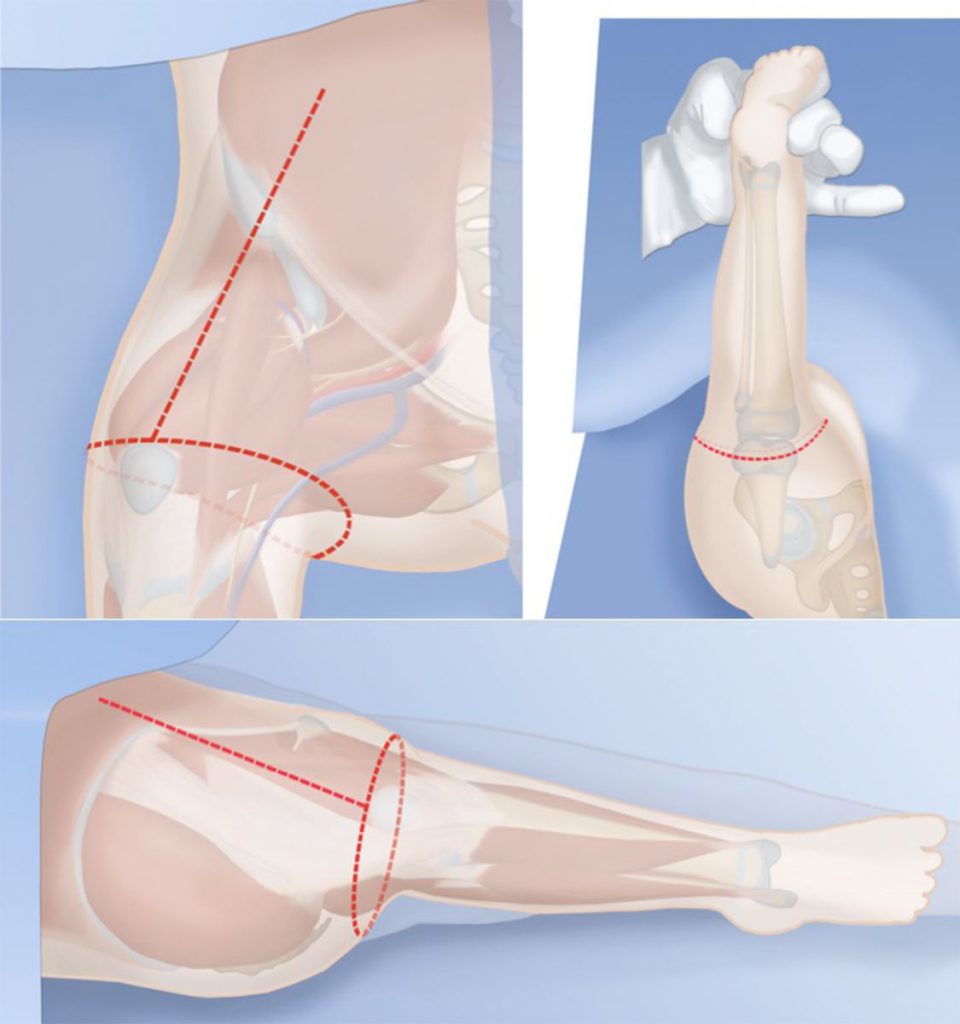
The following muscles are then disconnected:
This completely exposes the knee and hip joints. The nerves and arteries are preserved.
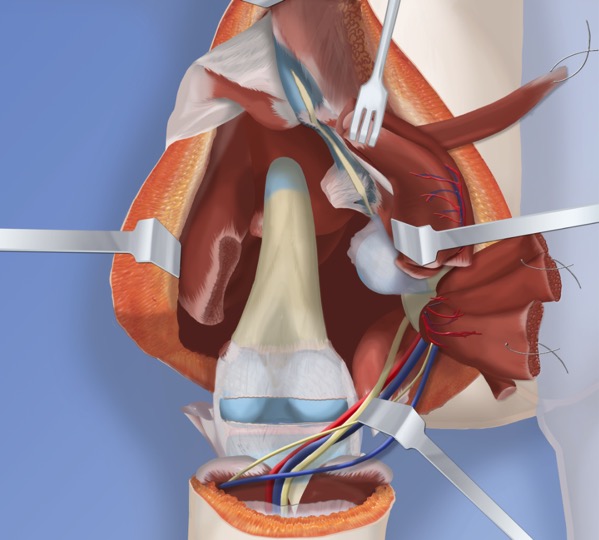
Since the femur is now untethered, it can be rotated 180 degrees.
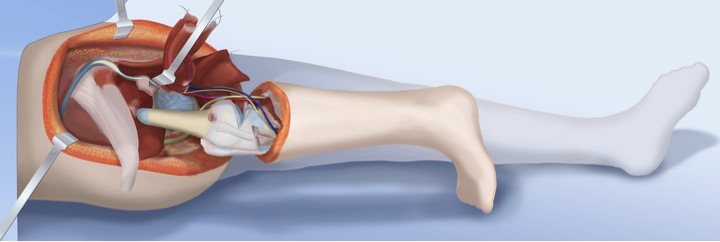
Next, the hip joint must be reconstructed by performing specialized osteotomies to the femur and pelvis. Dr. Paley will next perform an abductor slide and will remove the femoral head from the acetabulum.
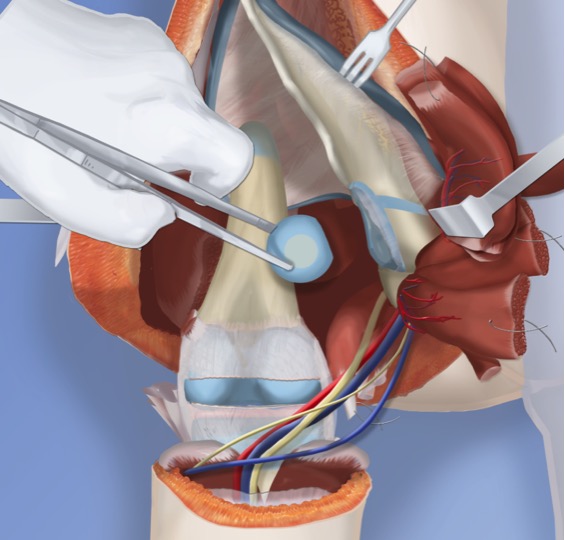
Dr. Paley will then perform the first osteotomy to the pelvis and remove a segment of bone.
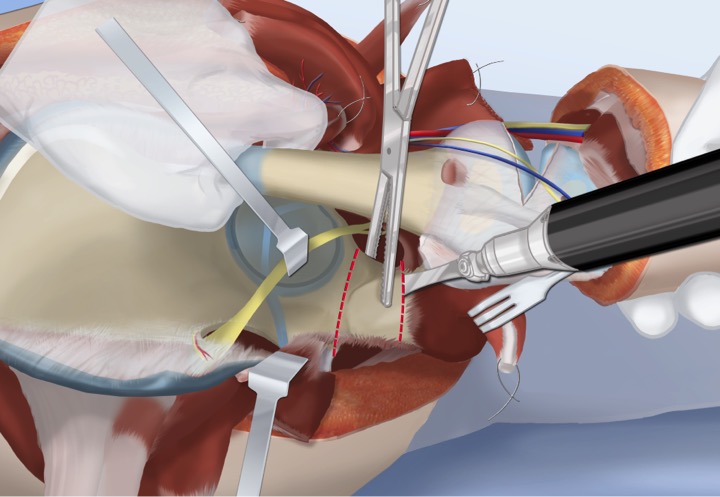

Dr. Paley then performs the second pelvic osteotomy, higher up on the pelvis.

The section of pelvis at the affected hip joint is then shifted over.
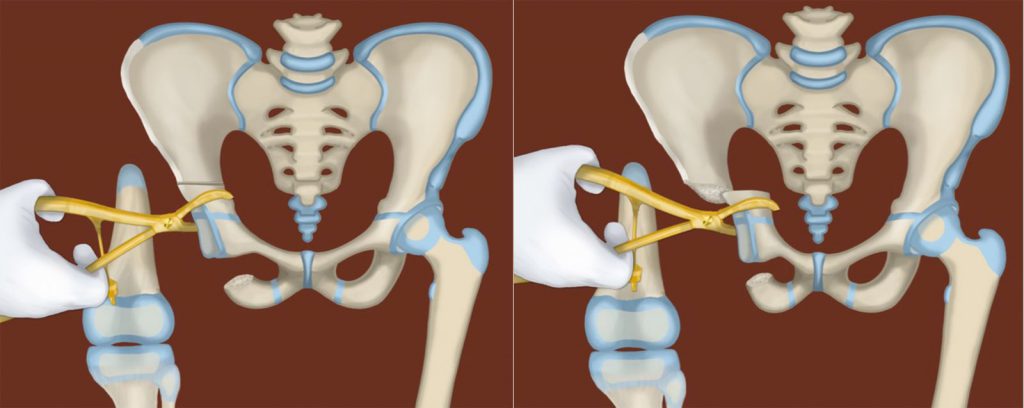
Dr. Paley will then perform the femoral osteotomy and remove the upper section of the femur.
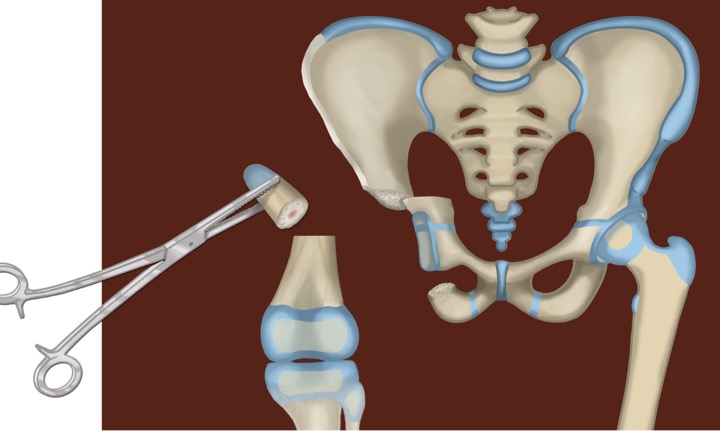
Next, the femur is shifted over into the new hip joint.
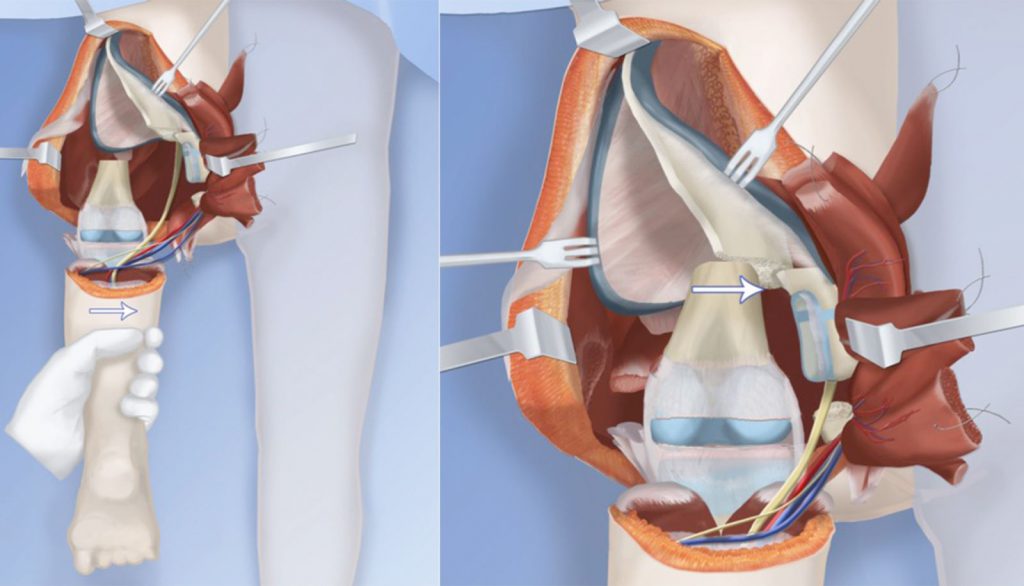
This alignment restores the 90-degree relationship between the pelvis and the shaft of the femur. The knee joint is now in position to act as the new hip joint.
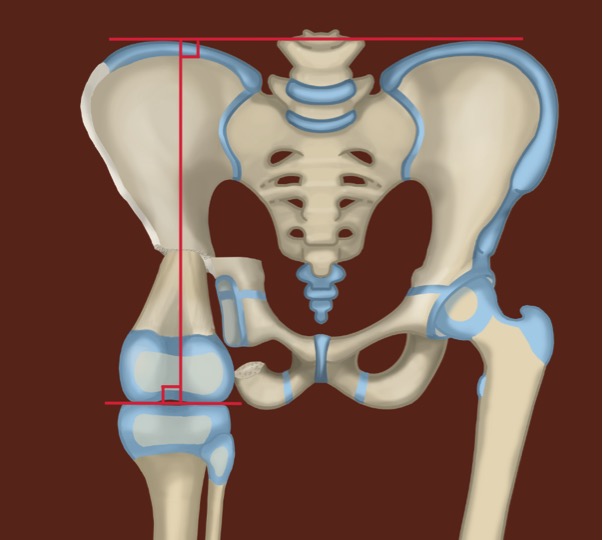
This alignment is held in place by three screws.
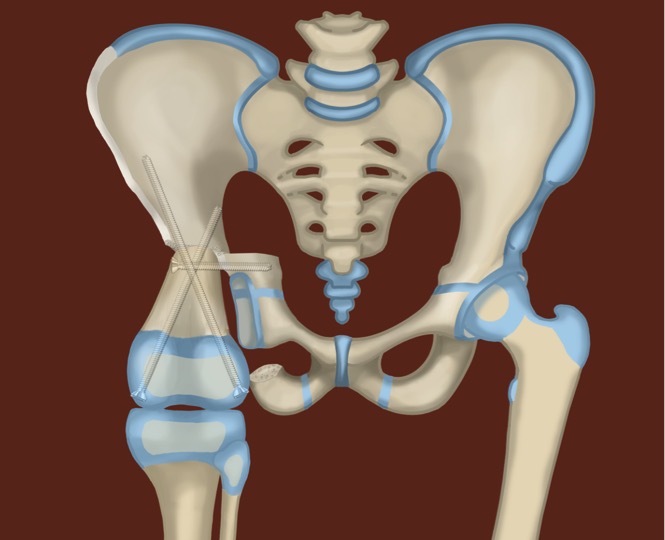
Finally, all of the muscles are reconnected and the incision is closed.
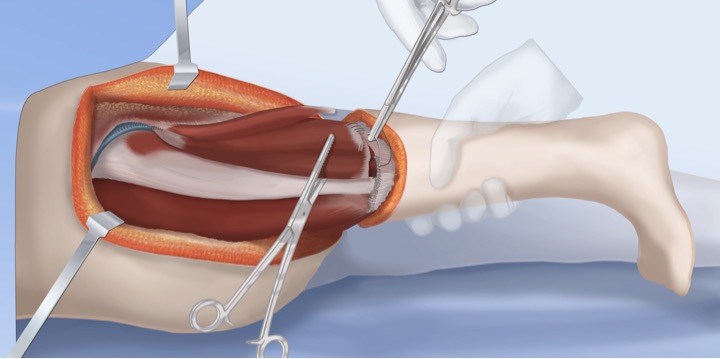
The knee joint now functions as the new hip joint. The muscles are reconnected to operate the knee as a hip joint. The ankle then becomes the new knee joint. A cast or an external fixator is used to hold the leg in place for three months.
After that, a prosthesis is fitted to the leg and foot. The movement of the ankle will function as a knee joint and the knee as a hip joint. The patient will be able to bend their new knee on their own by flexing their ankle joint. Rotationplasty is recommended because it allows the very powerful calf muscle, which is normally responsible for pushing off the foot, to function like the quadriceps muscles and extend the knee. This completes the Paley-modified-Brown Rotationplasty.
Источники информации:
- http://www.limblength.org/treatments/lengthening-deformity-correction-procedures/rotationplasty/
- http://www.oncolink.org/cancers/sarcomas/sarcoma-bone/rotationplasty
- http://medictionary.ru/rotacionnaya-plastika/
- http://paleyinstitute.org/blog/conditions/congenital-femoral-deficiency/treatment-strategies/rotationplasty/
